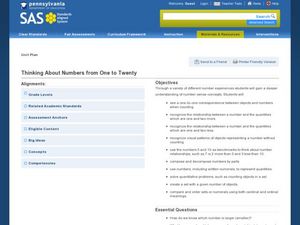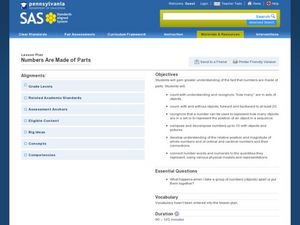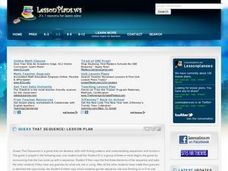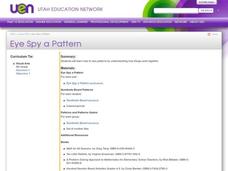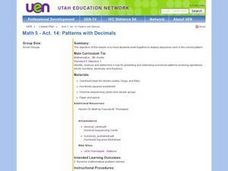Illustrative Mathematics
Complex number patterns
Start off with the definition of the imaginary number i, then have your class practice simplifying expressions involving powers of i and look for patterns. See how the cyclic nature of powers of i translate to sums of powers of i.
Curated OER
Math Practice-Grade 2
In this grade 2 math practice worksheet, students complete a set of 24 problems using a variety of grade 2 concepts. Answers are included.
Curated OER
Arranging Numbers from 1 to 5
Kindergarteners arrange manipulatives or everyday objects in groups of one through five. They identify groups seen in pictures of nature and compare same numbers of different objects.
Pennsylvania Department of Education
Thinking About Numbers from 1 to 20
Help your kindergarteners discover new number-sense concepts and to compose and decompose numbers. Though the resource contains no procedural details, the assessment tool (which you can find in the "printer friendly version") has lots of...
Pennsylvania Department of Education
Numbers Are Made of Parts
Children play with barnyard animal cards to practice composing and decomposing numbers. With their "secret number" of animal cards in a cup, they shake and spill them onto a barn story board, counting how many animals fall in the barn...
Curated OER
Numbers in Sequence
In this online patterns worksheet, students complete a variety of on line exercises including distinguishing between even and odd numbers, finding the missing numbers in sequences and solving eight number equations. Students check their...
Curated OER
Mental Math Problems
In this sequencing learning exercise, students make a number sequence chart by following the given rule, continue number sequences through seven additional numbers, and continue patterns. Students solve five multiple answer problems.
Curated OER
Unit 15 Negative Numbers
In this negative numbers worksheet, learners add and subtract positive and negative numbers. They find the terms in a sequence, complete multiplication numbers, and find the missing numbers in given multiplication problems. This...
Curated OER
Fractions and Recipes
Learners, working with their parents in real world situations, calculate to complete three word problems associated with multiplying and dividing fractions.
Curated OER
Guess That Sequence!
Students explore number sense by completing problems in class. In this patterns lesson plan, students examine a group of numbers and identify what the pattern is and how it should correctly continue. Students practice utilizing number...
EngageNY
Efficacy of Scientific Notation
How many times could California fit into the entire United States? Pupils use scientific notation to find the answer to that question in the 12th installment of 15 lessons. It asks scholars to write numbers in scientific notation and...
Curated OER
The Happy Game
The Happy Game will make your students smile! They play this game to review basic math concepts such as, finish the pattern, even and odd numbers, addition, subtraction, and word problems. Tip: Use this PowerPoint as a template to create...
Inside Mathematics
Graphs (2007)
Challenge the class to utilize their knowledge of linear and quadratic functions to determine the intersection of the parent quadratic graph and linear proportional graphs. Using the pattern for the solutions, individuals develop a...
Curated OER
Patterns
Fifth graders recognize shape and number patterns. In groups, 5th graders use strategies to find patterns. They extend the patterns and give explanations as to how they found the pattern. Students use the computer and the hundreds...
Curated OER
Eye Spy a Pattern
Fifth graders examine how to see patterns by showing how things work together. They identify, analyze and determine a rule for predicting and extending numberical patterns involving operations of whole numbers, decimals and fractions.
Curated OER
2, 4, 6, 8 . . .What Do We Appreciate-Patterns, Patterns, Patterns
Students discover and predict patterns in a numerical sequence. Through the Internet and video segments, students begin with basic number patterns and extend their knowledge into higher math skills. They will also create new patterns...
Curated OER
Patterns, Functions & Algebra
Students participate in numerous activities and games. In pairs, they play card games to find relationships between a random set of playing cards. After writing samples of Dear Abby letters concerning math problems, students create a...
Curated OER
Patterns and Sequences
Sixth graders explore pattern recognition and sequencing. They create arithmetic and geometric sequences with colors, shapes, and numbers. Students write expressions of arithmetic sequences and geometric sequences to find the nth term.
Curated OER
Patterns with Decimals
Fifth graders are given a set of manipulatives to use to develop patterns. In groups, they follow the directions to determine which blocks go with which pattern and put them into the correct sequence. To end the lesson, they complete a...
Curated OER
Learning about the World of Color, Object and Shape Patterns
First graders practice identifying and creating patterns by using unifix cubes. In this visual design lesson, 1st graders investigate reoccurring patterns using colors and shapes and extend what is being made with their unifix cubes....
Curated OER
Equivalent Mixed Numbers
Fifth graders use various internet sites to complete math programs where they identify different representations of mixed numbers. In this mixed numbers lesson plan, 5th graders practice math before hand and then go on the computers in...
Curated OER
Find a Pattern
In this patterns worksheet, 4th graders determine which patterns to use to solve 8 problems involving 2 math scenarios and then find the next 3 numbers in 2 groups of numbers.
Curated OER
Patterns: A Stitch in Time
Students recognize shapes, designs and numbers that form patterns. Using their surroundings, they identify common patterns. They create their own patterns in various software programs and share them with the class.
Curated OER
Find the Pattern
In this patterning activity, students use a chart to respond to 6 questions. Students decipher what patterns they are using to answer each of the given questions.





